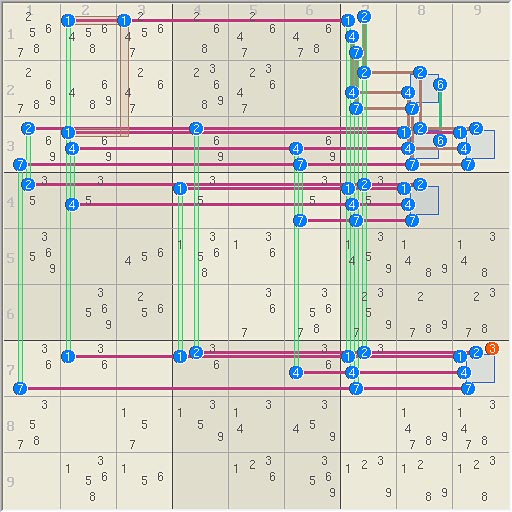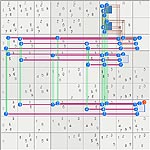ttt wrote:Now,I understand your concept. For eliminating r1c7=7, it look like “ floor + ”

:
- If r1c7=1 => r1c7<>7
- If r1c7<>1 => floor (247)r12c7 and the same as FM => pair (24)r12c7 => r1c7<>7 - on using URs at r12c37 & r12c57
Nothing wrong, but I would stress on the logic followed by the solver.
1) r12c7 is an AC2 having six possible supercandidates 1&2 1&4 1&7 2&4 2&7 4&7
2) each of the digit patterns in that AC2 lead to a unitary "bi bi" with r4c8 r7c9
so we have a full "bi bi" r12c7; r4c8;r7c9
3) No room for other digits in r4c8 r7c9 (no role later)
4) Each super candidate fill r4c8;r7c9 with the same digits.
analysing each bi-floors linked to supercandidates, it appears that
2&7;4&7 are not valid
(you try to do it in once, here it is searched in 2 independant steps)
5) we are left with still valid for r12c7 1&2 1&4 1&7 2&4
The last possibility for digit '7' is 1&7 => <7>rc7.
That sequence is stricly what the solver can find.
This is a reason why I stay cautious towards the fact that the solver can not find more in Silver Plate.
Opening the scope, it can be that a player can do more with the "bi bi" existing in that puzzle.
ttt wrote:champagne wrote:next elimination in GN proposed by the solver is <9>r3c2. You can try to find it. Folwing steps seem tougher.
I found :
1- If r3c2=1 => r3c2<>9
2- If r3c2<>1 => floor (247)r12c7 => pair (24)r12c7 => to avoid UR(24)r12c37 at least [(4)r5c3, (2)r6c3] must be true => r3c2<>9 but quite complex…
ttt
Again, let me tell why it seems to me that the "bi bi" view can make it relatively simple.
We have to keep in mind the findings made before and my assumprion is that, having a unique "bi bi", it is acceptable to study it in detail to ease the search.
- Code: Select all
25678 14568 1K24567 |268 2467 4678b |1i24 3 9 1&7 1&2 1&4 2&4
26789 4689 2467 |23a68Â9Ä 23A467 1 |247 246c7 5
2679 1i469 3 |269 5 4679Æ |8 1246C7 1247
-------------------------------------------------------------------
2d35 34e5 8 |1j35 9 357x |123457 1247 6
3569f 7 4E56 |13568b 1L36 2 |13459 1489 1348
1 3569F 2D56 |4 367À 35678B |23579 2789 2378
-------------------------------------------------------------------
367y 136 9 |12h36 8 34p6 |12347 5 1247
3578g 2 157z |135s9Æ 134q 345Ì9Í |6 14789Å 13478
4 13568G 156 |7 12H36 35r69Å |1239Ç 1289 1238
first of all, 9r3c2 - (1r3c2;1r1c7)
we have only one super candidate still valid in r1c7, so we must have 24r13c7.
I pick up the work done to check whether 2&4r13c7 coud be eliminated.
- Code: Select all
Last super candidate 2&4
digit 2 digit 4
... .X. X.. ..X ... X.. || ..X ... X.. ... .X. X..
... .X. X.. ..X ... X.. || ..X ... X.. ... .X. X..
X.. ... ... ... ..X ... || ... X.. ... .X. ... ...
... ... .X. .X. ... ... || X.. ... ... ... ... .X.
... ..o ... ... ... .X. || ... ..o ... ..X ... ...
..X ... ... ... o.. ... || ... ... .X. ... o.. ...
... X.. ... ... ... ..X || ... ... ..X ... ..X ...
.o. ... ... ... .X. ... || .o. ... ... ... ... ..X
... ... ..X o.. ... ... || ... .X. ... o.. ... ...
The right scenario has 4r3c2 which is not possible,
So we are sure that we have the left scenario and we rely on that
To go further in the simplest way,
I don't hesitate to insert the left scenario in the map(basic cleaning not done and small pieces of original tagging kept)
- Code: Select all
25678 14568 124567 |268 2467 4678 |24 3 9 1&7 1&2 1&4 2&4
26789 4689 2467 |23a689 23A467 1 |24 246c7 5
2 1i469 3 |269 5 4 |8 1246C7 1247
------------------------------------------------------------
2d35 4e 8 |1j35 9 357 |123457 2 6
3569 7 4E56 |13568 136 2 |13459 4 1348
1 3569 2D |4 367 35678 |23579 2789 2378
-----------------------------------------------------------
367 136 9 |2h 8 346 |12347 5 4
3578 2 157 |1359 4 3459 |6 14789 13478
4 13568 156 |7 12H36 35r69 |1239 1289 2
and now the complementary pieces of AIC's
#[]9r3c2=>2r1c5 []2r9c5.H - 9r3c2
[]2r2c5 - 3r2c5 = 3r2c4 - 9r2c4 = 9r3c46 - 9r3c2
#[]9r3c2=>2r2c7 trivial after 2r1c5
#[]9r3c2 => 7r2c1 AC:r2c124
[]2r2124 - 2r2c7 <=9r3c2
[]4r2c2 - 4r4c2 <=9r3c2
[}6r2c124 - 6r2c8 <=6r3c4 <=9r3c2
#[]9r3c2=>7r6c5
[]7r1c5 - 2r1c5 <= 9r3c2
[]7r2c5 - 3r2c5 <= 9r3c2
and with our simplified map
clear []9r3c2 => 7r2c1 - 7r7c1 = 7r7c7 - 7r4c7 = 7r4c6 - 7r6c5 <= 9r3c2
No problem to put all that in AIC's net.
champagne




